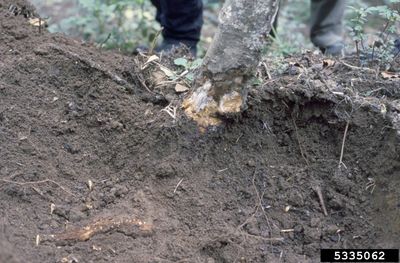Armillaria Root Rot on Apples
Armillaria root rot is caused by several fungal pathogens of the species Armillaria. These fungi can be relentless and stealthy, making it hard to know if you have an infection unless you’ve been watching very closely. Ultimately, Armillaria will kill most trees and woody plants it comes in contact with, so it is not a disease to ignore. It can linger in infected stumps and large pieces of underground roots for years or decades, sending out long, reddish brown, shoestring-like rhizomorphs in search of new trees to infect. Symptoms of Armillaria in apples may be subtle at first, with signs of stress like drooping or leaf curl along the midrib, leaf bronzing and wilting, or branch dieback. You might also notice yellowish gold mushrooms growing at the base of infected trees in the fall or winter – these are the fruiting bodies of the fungus. As the infection takes a stronger hold, your apple tree may develop large dark-colored, oozing cankers and mycelial fans, white fan-like structures, under the bark. Your tree may also start its fall color change earlier than usual, or even collapse suddenly.
Armillaria Root Rot Treatment
Unfortunately, there’s no known treatment for Armillaria root rot, so homeowners and farmers alike are left with few solutions for an infected apple orchard. Exposing the crown of the tree can help slow the growth of the fungus, however, giving you more time with your plant. In the spring, remove soil to a depth of 9 to 12 inches (23-31 cm.) around the base of the tree and leave it exposed for the rest of the growing season. Keeping this area dry is vital, so if drainage is a problem, you’ll also need to dig a trench to divert water away. If your apple succumbs to Armillaria root rot, your best bet is to replant with a less susceptible species, such as pear, fig, persimmon, or plum. Always verify the Armillaria tolerance of the variety you choose, since some are more resistant than others. Do not plant a new tree anywhere near the old one without removing the infected stump, as well as any major roots, completely. Waiting a year or two after removal is even better, since this will give time for any small root pieces you may have missed to break down entirely.
